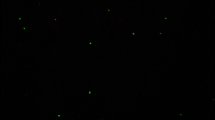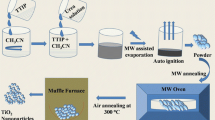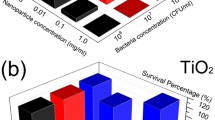Abstract
Nano-titania is widely used in the food industry due to its efficient antimicrobial activity. However, the mechanism of microbial toxicity of nano-titania is poorly known. Here, nano-TiO2 has been fabricated by microwave-irradiation chemistry, a new method, and then tested for antimicrobial activity. Mutagenicity of nano-TiO2 was evaluated using Salmonella typhimurium histidine-auxotrophic strains. The reactive oxygen generation test was performed using 2,7-dichlorofluorescein diacetate dye. To test membrane permeabilization, E. coli cultures were grown in nutrient broth at an optical density of 0.3–0.5 at 610 nm, harvested by centrifugation at 11,000g for 10 min, washed and resuspended in 0.5 % NaCl solution. We also analyzed superoxide formation and membrane integrity, and we used scanning electron microscopy. Results show that nano-TiO2 has a minimum inhibitory concentration of 15 µg/mL, and a minimum bactericidal concentration of 20 µg/mL for E. coli. The bacterial inner wall was ruptured, and cytoplasmic content was released after 5 min of treatment in a dose-dependent manner. Notably, superoxide formation was not observed, which establishes the fact that reactive oxygen generation and alteration of membrane integrity, as well as permeability, is the major mechanism of antimicrobial activity of nano-TiO2.



Similar content being viewed by others
References
Akyil D, Eren Y, Konuk M et al (2015) Determination of mutagenicity and genotoxicity of indium tin oxide nanoparticle using the Ames test and micronucleus assay. Toxicol Ind Health 1–9:0748233715579804. doi:10.1177/0748233715579804
Arakha M, Pal S, Samantarrai D et al (2015) Antimicrobial activity of iron oxide nanoparticle upon modulation of nanoparticle-bacteria interface. Sci Rep 5:14813. doi:10.1038/srep14813
Beevers C, Adamson RH (2016) Evaluation of 4-methylimidazole, in the Ames/Salmonella test using induced rodent liver and lung S9. Environ Mol Mutagen 57:51–57
Das B, Dash SK, Mandal D et al (2015) Green synthesized silver nanoparticles destroy multidrug resistant bacteria via reactive oxygen species mediated membrane damage. Arab J Chem. doi:10.1016/j.arabjc.2015.08.008
Dasgupta N, Ranjan S, Rajendran B et al (2016) Thermal co-reduction approach to vary size of silver nanoparticle: its microbial and cellular toxicology. Env Sci Pol Res 23:4149–4163
Deokar AR, Lin L-Y, Chang C-C, Ling Y-C (2013) Single-walled carbon nanotube coated antibacterial paper: preparation and mechanistic study. J Mater Chem B 1:2639–2646. doi:10.1039/C3TB20188K
Dwivedi S, Wahab R, Khan F et al (2014) Reactive oxygen species mediated bacterial biofilm inhibition via zinc oxide nanoparticles and their statistical determination. PLoS One 9:e111289
Ivask A, Bondarenko O, Jepihhina N, Kahru A (2010) Profiling of the reactive oxygen species-related ecotoxicity of CuO, ZnO, TiO2, silver and fullerene nanoparticles using a set of recombinant luminescent Escherichia coli strains: differentiating the impact of particles and solubilised metals. Anal Bioanal Chem 398:701–716. doi:10.1007/s00216-010-3962-7
Janardan S, Suman P, Ragul G et al (2016) Assessment on antibacterial activity of nanosized silica derived from hypercoordinated silicon(iv) precursors guidelines to the referees. RSC Adv. doi:10.1039/C6RA12189F
Kim HR, Kim MJ, Lee SY et al (2011) Genotoxic effects of silver nanoparticles stimulated by oxidative stress in human normal bronchial epithelial (BEAS-2B) cells. Mutatagen Res 726:129–135. doi:10.1016/j.mrgentox.2011.08.008
Kim HR, Park YJ, Shin DY et al (2013) Appropriate in vitro methods for genotoxicity testing of silver nanoparticles. Environ Health Toxicol 28:e2013003. doi:10.5620/eht.2013.28.e2013003
Kurokawa Y, Maekawa A, Takahashi M, Hayashi Y (1990) Toxicity and carcinogenicity of potassium bromate—a new renal carcinogen. Environ Health Perspect 87:309–335
Landsiedel R, Kapp MD, Schulz M et al (2009) Genotoxicity investigations on nanomaterials: methods, preparation and characterization of test material, potential artifacts and limitations—many questions, some answers. Mutat Res Mutat Res 681:241–258. doi:10.1016/j.mrrev.2008.10.002
Li Y, Chen DH, Yan J et al (2012) Genotoxicity of silver nanoparticles evaluated using the Ames test and in vitro micronucleus assay. Mutat Res Toxicol Environ Mutagen 745:4–10. doi:10.1016/j.mrgentox.2011.11.010
Li H, Chen Q, Zhao J, Urmila K (2015) Enhancing the antimicrobial activity of natural extraction using the synthetic ultrasmall metal nanoparticles. Sci Rep. doi:10.1038/srep11033
Llana-ruiz-cabello M, Maisanaba S, Puerto M et al (2014) Evaluation of the mutagenicity and genotoxic potential of carvacrol and thymol using the Ames Salmonella test and alkaline, Endo III- and FPG-modified comet assays with the human cell line Caco-2. Food Chem Toxicol 72:122–128. doi:10.1016/j.fct.2014.07.013
Maenosono S, Suzuki T, Saita S (2007) Mutagenicity of water-soluble FePt nanoparticles in Ames test. J Toxicol Sci 32:575–579
Maron DM, Ames BN (1983) Revised methods for the Salmonella mutagenicity test. Mutat Res Mutagen Relat Subj 113:173–215. doi:10.1016/0165-1161(83)90010-9
Meghana S, Kabra P, Chakraborty S, Padmavathy N (2015) Understanding the pathway of antibacterial activity of copper oxide nanoparticles. RSC Adv 5:12293–12299. doi:10.1039/C4RA12163E
Priester JH, Singhal A, Wu B et al (2014) Integrated approach to evaluating the toxicity of novel cysteine-capped silver nanoparticles to Escherichia coli and Pseudomonas aeruginosa. Analyst 139:954–963. doi:10.1039/c3an01648j
Qiu S, Deng F, Xu S et al (2015) Degradation of pollutant and antibacterial activity of waterborne polyurethane/doped TiO2 nanoparticle hybrid films. J Wuhan Univ Technol Sci Ed 30:447–451. doi:10.1007/s11595-015-1169-7
Ranjan S, Dasgupta N, Chakraborty AR et al (2014) Nanoscience and nanotechnologies in food industries: opportunities and research trends. J Nanoparticle Res 16:1–23. doi:10.1007/s11051-014-2464-5
Ranjan S, Dasgupta N, Ganesh SA et al (2016a) Microwave-irradiation-assisted hybrid chemical approach for titanium dioxide nanoparticle synthesis: microbial and cyto-toxicological evaluation. Environ Sci Pollut Res 23:12287–12302. doi:10.1007/s11356-016-6440-8
Ranjan S, Dasgupta N, Rajendran B et al (2016b) Microwave-irradiation-assisted hybrid chemical approach for titanium dioxide nanoparticle synthesis: microbial and cytotoxicological evaluation. Env Sci Pollut Res. doi:10.1007/s11356-016-6440-8
Ranjan S, Dasgupta N, Srivastava P, Ramalingam C (2016c) A spectroscopic study on interaction between bovine serum albumin and titanium dioxide nanoparticle synthesized from microwave-assisted hybrid chemical approach. J Photochem Photobiol B Biol 161:472–481. doi:10.1016/j.jphotobiol.2016.06.015
Shi H, Magaye R, Castranova V, Zhao J (2013) Titanium dioxide nanoparticles: a review of current toxicological data. Part Fibre Toxicol 10:15. doi:10.1186/1743-8977-10-15
Wang D, Zhang W, Wang T et al (2015a) Unveiling the mode of action of two antibacterial tanshinone derivatives. Int J Mol Sci 16:17668–17681. doi:10.3390/ijms160817668
Wang R, Peng L, Zhao J et al (2015b) Gardenamide A protects RGC-5 cells from h2o2-induced oxidative stress insults by activating PI3K/Akt/eNOS signaling pathway. Int J Mol Sci 16:22350–22367
Woodruff RS, Li Y, Yan J et al (2012) Genotoxicity evaluation of titanium dioxide nanoparticles using the Ames test and Comet assay. J Appl Toxicol 32:934–943. doi:10.1002/jat.2781
Xing K, Chen XG, Kong M et al (2009) Effect of oleoyl-chitosan nanoparticles as a novel antibacterial dispersion system on viability, membrane permeability and cell morphology of Escherichia coli and Staphylococcus aureus. Carbohydr Polym 76:17–22. doi:10.1016/j.carbpol.2008.09.016
Yoshida R, Kitamura D, Maenosono S (2009) Mutagenicity of water-soluble ZnO nanoparticles in Ames test. J Toxicol Sci 34:119–122
Zimbone M, Buccheri MA, Cacciato G et al (2015) Photocatalytical and antibacterial activity of TiO2 nanoparticles obtained by laser ablation in water. Appl Catal B Environ 165:487–494. doi:10.1016/j.apcatb.2014.10.031
Acknowledgments
Authors are acknowledging the Department of Biotechnology (DBT, India) for the funded project with permanent project number—BT/PR10414/PFN/20/961/2014.
Author information
Authors and Affiliations
Corresponding author
Rights and permissions
About this article
Cite this article
Ranjan, S., Ramalingam, C. Titanium dioxide nanoparticles induce bacterial membrane rupture by reactive oxygen species generation. Environ Chem Lett 14, 487–494 (2016). https://doi.org/10.1007/s10311-016-0586-y
Received:
Accepted:
Published:
Issue Date:
DOI: https://doi.org/10.1007/s10311-016-0586-y




